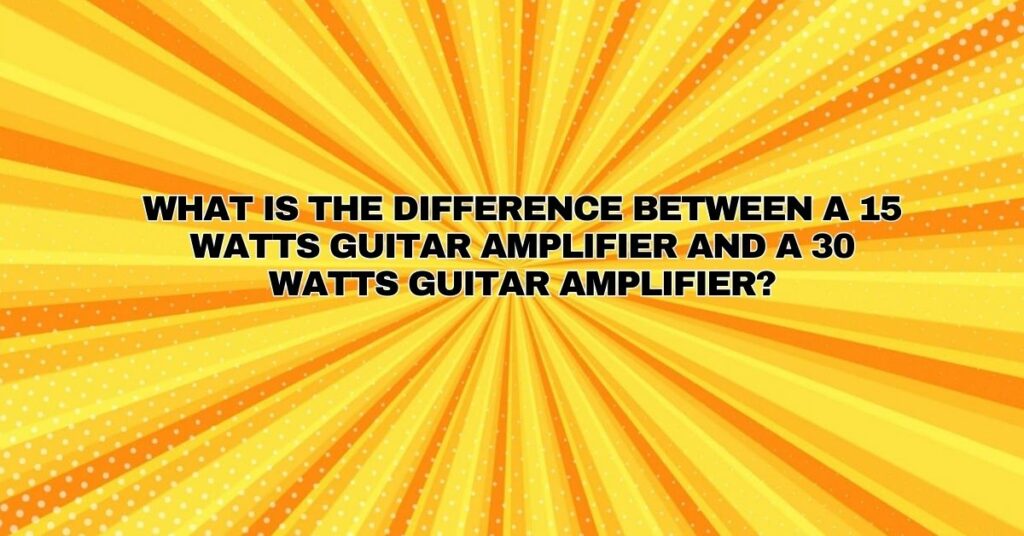Guitar amplifiers come in a wide range of wattages, and the choice between a 15-watt and a 30-watt amplifier can significantly impact your tone, playing experience, and the versatility of your rig. In this comprehensive guide, we’ll explore the key differences between 15-watt and 30-watt guitar amplifiers, helping you make an informed decision when selecting the right amp for your musical needs.
Wattage: What Does It Mean?
Wattage, in the context of guitar amplifiers, refers to the power output of the amplifier. It dictates the volume the amplifier can produce and how it responds to your playing. While higher wattage generally means more volume, there are other important considerations when choosing between 15 and 30 watts.
15-Watt Guitar Amplifiers
A 15-watt guitar amplifier is often considered ideal for home practice, recording, and smaller venues. Here’s what you need to know about these amplifiers:
- Volume: 15-watt amps provide enough volume for home practice, band rehearsals, and small gigs in intimate venues. They are often sufficient for most musicians’ needs.
- Tone and Clean Headroom: Lower-wattage amplifiers tend to produce overdrive and distortion at lower volume levels, which can be advantageous if you’re looking for that natural tube amp saturation. However, they have less clean headroom, making it harder to maintain a clean tone at higher volumes.
- Portability: 15-watt amplifiers are typically more compact and lightweight, making them convenient for musicians on the move.
- Sensitivity to Pedals: Lower-wattage amplifiers tend to be more sensitive to pedal effects, and they can often create richer, harmonically complex overdrive when paired with distortion or overdrive pedals.
- Breakup and Compression: 15-watt amps reach their maximum power output (breakup) at a lower volume, resulting in a compressed and saturated tone, which can be highly desirable for certain styles of music, such as blues or rock.
30-Watt Guitar Amplifiers
A 30-watt guitar amplifier offers more power and clean headroom, making it a popular choice for a broader range of applications. Here are the key points to consider:
- Volume: 30-watt amps can produce more volume compared to their 15-watt counterparts, making them suitable for larger gigs and venues. They provide more headroom for clean tones at higher volumes.
- Clean Tone: These amplifiers offer ample clean headroom, allowing you to maintain pristine, clear tones even at higher volumes. This is beneficial for genres that require clean and undistorted sounds.
- Versatility: 30-watt amplifiers are versatile and can handle various music styles. They can be pushed into overdrive, but the higher headroom means they respond differently to distortion compared to lower-wattage amps.
- Effect Pedals: While 30-watt amplifiers can be sensitive to pedals, they may not generate as much harmonic complexity and saturation as lower-wattage amps when overdriven by pedals.
- Weight and Size: Typically, 30-watt amplifiers are slightly larger and heavier than their 15-watt counterparts, which might affect portability.
Which One Should You Choose?
The choice between a 15-watt and a 30-watt guitar amplifier ultimately depends on your specific needs and playing style:
- 15-Watt Amplifier: Consider a 15-watt amp if you primarily play at home, in smaller venues, or if you desire that classic, overdriven tube amp sound at lower volumes.
- 30-Watt Amplifier: Opt for a 30-watt amp if you require more volume for larger gigs or if you need pristine, clean tones for jazz, country, or genres where clean headroom is essential.
Remember that wattage is just one factor when selecting an amplifier. The amplifier’s type (e.g., tube, solid-state, modeling), speaker size, and overall design also contribute to the final sound. Carefully consider your musical goals and requirements, test amplifiers whenever possible, and choose the one that best complements your playing style and preferences.


